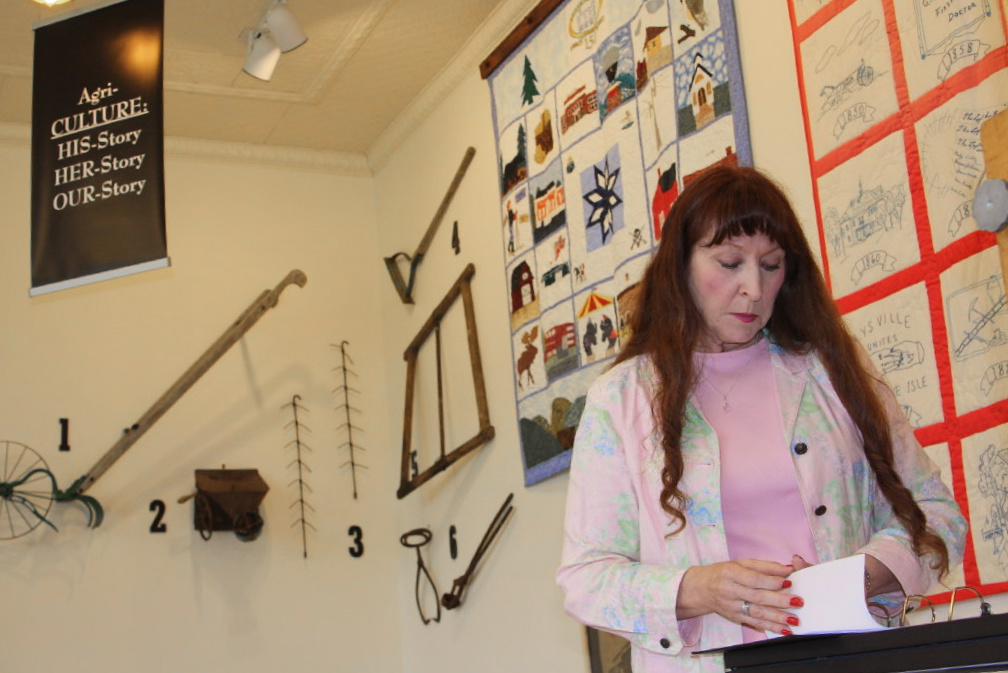
PRESQUE ISLE, Maine — As the Presque Isle Historical Society’s new Maysville Museum closes on its first season, a local woman has shed some light on the origins of the former town’s name.
The Maysville Museum, celebrating what is now the northern half of Presque Isle, opened this past summer and drew a healthy amount of visitors until it closed for the season in late October, said Craig Green, board president of the Presque Isle Historical Society.
“It’s been fantastic,” Green said, noting that 250 people showed up the first weekend to see the former one-room schoolhouse, town hall and grange.

Visitors enjoy viewing items related to Theodore “Teddy” Roosevelt and other artifacts at the Presque Isle Historical Society’s Maysville Museum during its recent Roosevelt Day. At front left, author Andrew Vietze signs a copy of one of his books for a visitor.
(Courtesy of Kim Smith)
Maysville was settled around the same time as Presque Isle when Maine gained statehood and was annexed by Presque Isle in 1883. The building that is now the Maysville Museum, at the corner of Brewer Road and Route 1, served as a schoolhouse until the 1940s and as a grange hall for local farmers into the 1980s.
Green said that quite a few people who grew up in the area visited the museum and shared memories.
“They started sharing stories: We went to school here, grandmom went to school here or someone taught here,” Green recounted. “Some of these folks are in their 70s and 80s and may not get back here for another summer.”
The Maysville Museum has four permanent exhibits covering the town of Maysville as well as aspects of Presque Isle and Aroostook County history: Presque Isle and the Civil War, the Aroostook War, the rise of Aroostook agriculture, and Presque Isle’s one-room schoolhouses.
For its last weekend in October, the museum celebrated the birthday of President Teddy Roosevelt, whose hunting trips in Aroostook County turned out to be instrumental in his conservation advocacy.
“He came here hunting and formed a lifelong friendship with his two guides,” said Kim Smith, a Presque Isle Historical Society board member. A new book, “Becoming Teddy Roosevelt,” recounts Roosevelt’s Maine hunting trips and his friendships with local guides. The Maysville Museum also has two artifacts from his time here, including a long barrel Colt revolver and a birch-bark moose caller.
While the museum drew local interest this summer and fall, in November the Presque Isle Historical Society was honored by the nonprofit Maine Preservation organization for restoring the Maysville building. The Maysville building had long sat vacant until it was taken over, renovated and repurposed by the Presque Isle Historical Society.
Maysville played a key role in the evolution of Aroostook County, Smith said. Henry Rolfe, who served in the Civil War, planted the first acre of potatoes in Aroostook County in Maysville, Smith said. John Watson, who invented the horse-drawn potato sprayer in Houlton, was born there, and the town hosted some of the skirmishes with Canadians that led to the Aroostook War and the agreement on the modern Maine-Canada boundary.
But some aspects of Maysville’s history have remained a mystery — especially its name.

This photo taken in the early 1940s is of unidentified students at the Maysville School. The teacher at the time was Mildred (Smart) Kierstead. If anyone knows more about this photo, they are encouraged to email Christie Cochran at gramchristie@yahoo.com.
(Contributed)
“We get asked that quite a bit,” Smith said Wednesday of Maysville’s name. “Our typical response is, ‘You know, we don’t know.’”
There are few official records from Maysville, Smith said. “Maysville was annexed by Presque Isle in 1883 and the town hall burned down twice. From the reports I’ve read, the first time it burned down they lost almost all of the records.”
Washburn resident, author and former Star-Herald contributor Christie Cochran, however, believes she recently found a likely explanation for the town’s name.
According to Cochran’s research, the town appears to have been named after what was then known as May Mountain (now the site of the Nordic Heritage Center) where each spring families would gather for a picnic on the first Sunday of May.
“Due to the name of the month, they referred to the place as ‘May Mountain,’” Cochran said, citing a Sept. 9, 1863, article in the Loyal Sunrise, a Presque Isle newspaper published from 1863 to 1867.
When the town’s official name was decided upon for its incorporation in 1859, this name derived from the mountain was chosen by townspeople, according to Cochran.
Smith said she thinks that’s a viable explanation.
“It would not be the only time in local history that a church youth group was credited with helping along history,” Smith said, noting that a youth group with the Presque Isle Congregational Church installed the first street signs in Presque Isle.
Cochran found the newspaper article in the archives of the Turner Memorial Library, and has prepared an article and bibliography outlining the origins of the town’s name.
“It took me a long time and a lot of work reading and hunting,” Cochran said. “But I found it.”




